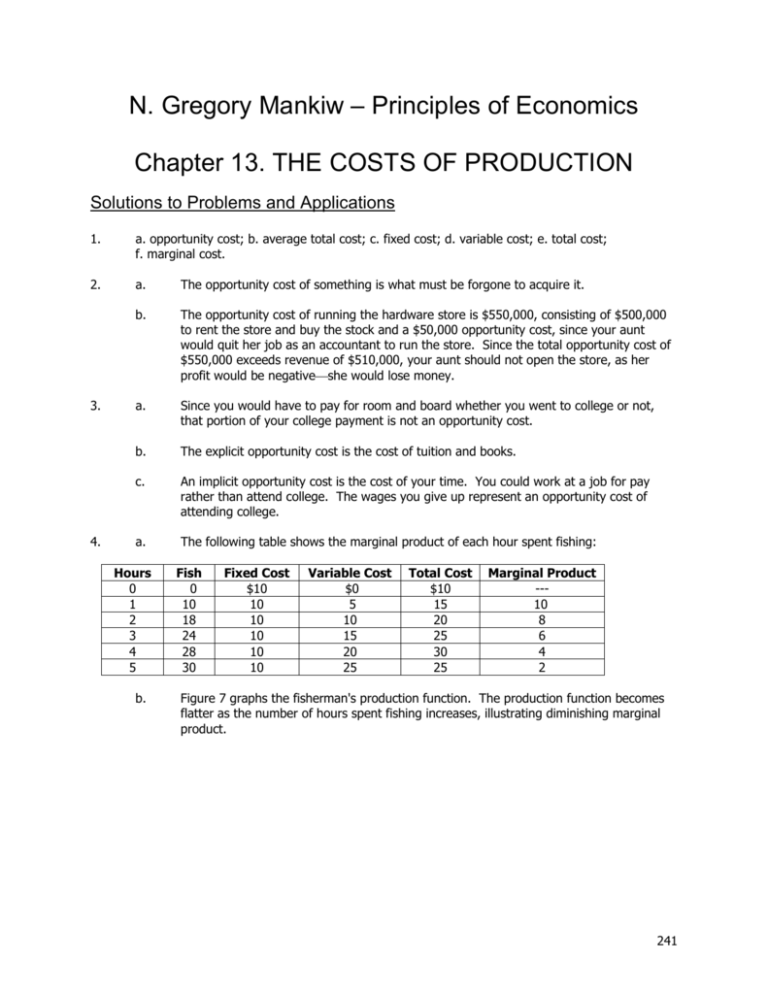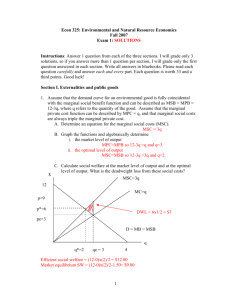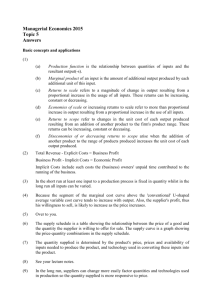N. Gregory Mankiw – Principles of Economics Chapter 13. THE
advertisement

N. Gregory Mankiw – Principles of Economics Chapter 13. THE COSTS OF PRODUCTION Solutions to Problems and Applications 1. a. opportunity cost; b. average total cost; c. fixed cost; d. variable cost; e. total cost; f. marginal cost. 2. a. The opportunity cost of something is what must be forgone to acquire it. b. The opportunity cost of running the hardware store is $550,000, consisting of $500,000 to rent the store and buy the stock and a $50,000 opportunity cost, since your aunt would quit her job as an accountant to run the store. Since the total opportunity cost of $550,000 exceeds revenue of $510,000, your aunt should not open the store, as her profit would be negative⎯she would lose money. a. Since you would have to pay for room and board whether you went to college or not, that portion of your college payment is not an opportunity cost. b. The explicit opportunity cost is the cost of tuition and books. c. An implicit opportunity cost is the cost of your time. You could work at a job for pay rather than attend college. The wages you give up represent an opportunity cost of attending college. a. The following table shows the marginal product of each hour spent fishing: 3. 4. Hours 0 1 2 3 4 5 b. Fish 0 10 18 24 28 30 Fixed Cost $10 10 10 10 10 10 Variable Cost $0 5 10 15 20 25 Total Cost $10 15 20 25 30 25 Marginal Product --10 8 6 4 2 Figure 7 graphs the fisherman's production function. The production function becomes flatter as the number of hours spent fishing increases, illustrating diminishing marginal product. 241 Chapter 13 Figure 7 c. The table shows the fixed cost, variable cost, and total cost of fishing. Figure 8 shows the fisherman's total-cost curve. It slopes up because catching additional fish takes additional time. The curve is convex because there are diminishing returns to fishing time⎯each additional hour spent fishing yields fewer additional fish. Figure 8 Chapter 13 5. Here is the table of costs: Workers Output 0 1 2 3 4 5 6 7 0 20 50 90 120 140 150 155 Marginal Product --20 30 40 30 20 10 5 Total Cost $200 300 400 500 600 700 800 900 Average Total Cost --$15.00 8.00 5.56 5.00 5.00 5.33 5.81 Marginal Cost --$5.00 3.33 2.50 3.33 5.00 10.00 20.00 a. See table for marginal product. Marginal product rises at first, then declines because of diminishing marginal product. b. See table for total cost. c. See table for average total cost. Average total cost is U-shaped. When quantity is low, average total cost declines as quantity rises; when quantity is high, average total cost rises as quantity rises. d. See table for marginal cost. Marginal cost is also U-shaped, but rises steeply as output increases. This is due to diminishing marginal product. e. When marginal product is rising, marginal cost is falling, and vice versa. f. When marginal cost is less than average total cost, average total cost is falling; the cost of the last unit produced pulls the average down. When marginal cost is greater than average total cost, average total cost is rising; the cost of the last unit produced pushes the average up. 6. Fixed costs include the cost of owning or renting a car to deliver the bagels and the cost of advertising; they are fixed costs because they do not vary with output. Variable costs include the cost of the bagels and gas for the car, since those costs will increase as output increases. 7. a. The fixed cost is $300, since fixed cost equals total cost minus variable cost. b. Quantity 0 1 2 3 4 5 6 Total Cost $300 350 390 420 450 490 540 Variable Cost $0 50 90 120 150 190 240 Marginal Cost (using total cost) --$50 40 30 30 40 50 Marginal Cost (using variable cost) --$50 40 30 30 40 50 Marginal cost equals the change in total cost or the change in variable cost. That is because total cost equals variable cost plus fixed cost and fixed cost does not change as the quantity changes. So as quantity increases, the increase in total cost equals the Chapter 13 increase in variable cost and both are equal to marginal cost. 8. a. The fixed cost of setting up the lemonade stand is $200. The variable cost per cup is 50 cents. Figure 9 b. The following table shows total cost, average total cost, and marginal cost. These are plotted in Figure 9. Quantity 0 1 2 3 4 5 6 7 8 9 10 Total Cost $200 208 216 224 232 240 248 256 264 272 280 Average Total Cost --$208 108 74.7 58 48 41.3 36.6 33 30.2 28 Marginal Cost --$8 8 8 8 8 8 8 8 8 8 Chapter 13 9. The following table illustrates average fixed cost (AFC), average variable cost (AVC), and average total cost (ATC) for each quantity. The efficient scale is 4 houses per month, since that minimizes average total cost. Quantity 0 1 2 3 4 5 6 7 10 a. Variable Cost $0 10 20 40 80 160 320 640 Total Cost $200 210 220 240 280 360 520 840 Average Fixed Cost --$200 100 66.7 50 40 33.3 28.6 Average Variable Cost --$10 10 13.3 20 32 53.3 91.4 Average Total Cost --$210 110 80 70 72 86.7 120 The following table shows average variable cost (AVC), average total cost (ATC), and marginal cost (MC) for each quantity. Quantity 0 1 2 3 4 5 6 b. Fixed Cost $200 200 200 200 200 200 200 200 Variable Cost $0 10 25 45 70 100 135 Total Cost $30 40 55 75 100 130 165 Average Variable Cost --$10 12.5 15 17.5 20 22.5 Average Total Cost --$40 27.5 25 25 26 27.5 Marginal Cost --$10 15 20 25 30 35 Figure 10 graphs the three curves. The marginal cost curve is below the average total cost curve when output is less than 4, as average total cost is declining. The marginal cost curve is above the average total cost curve when output is above 4, as average total cost is rising. The marginal cost curve lies above the average variable cost curve. Figure 10 Chapter 13 11. The following table shows quantity (Q), total cost (TC), and average total cost (ATC) for the three firms: Firm A Quantity 1 2 3 4 5 6 7 Firm B Firm C TC ATC TC ATC TC ATC 60 70 80 90 100 110 120 60 35 26.7 22.5 20 18.3 17.1 11 24 39 56 75 96 119 11 12 13 14 15 16 17 21 34 49 66 85 106 129 21 17 16.3 16.5 17 17.7 18.4 Firm A has economies of scale since average total cost declines as output increases. Firm B has diseconomies of scale since average total cost rises as output rises. Firm C has economies of scale for output from 1 to 3, then diseconomies of scale for greater levels of output.







